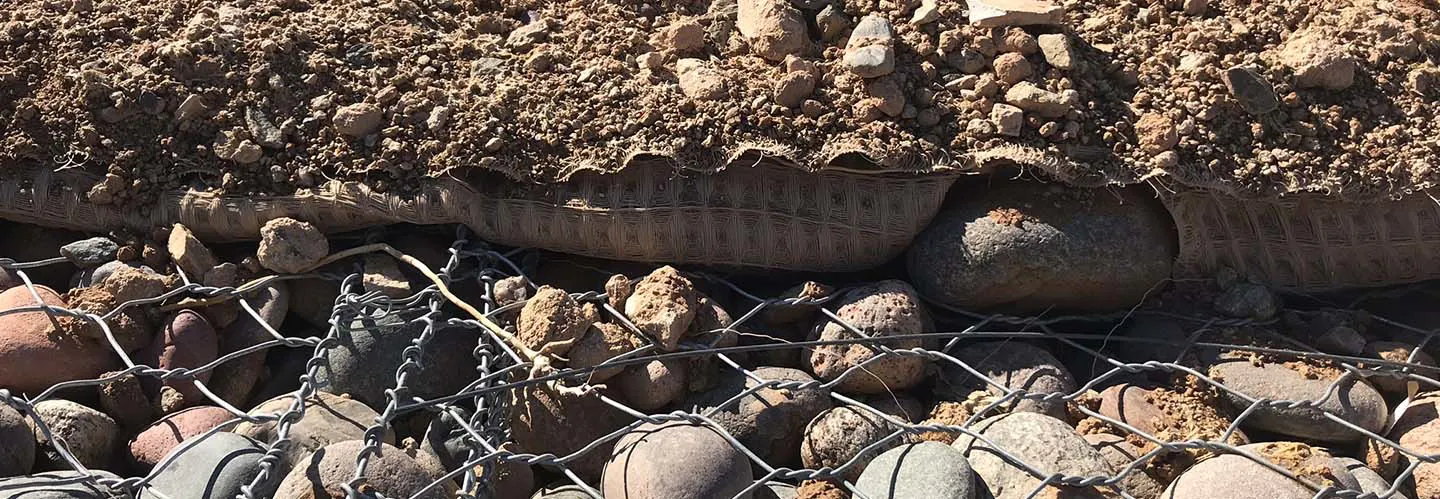
How to securely connect PROPEX Pyramat with traditional engineering solutions
Most PROPEX® Pyramat® 25 TRM and PROPEX Pyramat 75 HPTRM installations utilize recommended trenches at the top, toe, and sides of slopes or channels to anchor them. This minimizes wind displacement and prevents storm water from flowing underneath, reducing erosion.
Though PROPEX Pyramat is effective on its own, it can be combined with traditional solutions like concrete, rock riprap, and gabions for enhanced results. When standard trench installation isn’t feasible with these combinations, Propex offers transitional mechanical connection solutions.
Concrete connections:
Bolt connection: Bolts, 1.9 cm (¾ in) in diameter and spaced every 61 cm (2 ft), anchor PROPEX Pyramat to concrete. The material is adjusted to fit over the bolt and secured with a washer of at least 3.8 cm (1.5 in) in diameter. The concrete's thickness is crucial for installation integrity and pullout resistance. *(See Figures 1-3)*.
Hilti Shot connection: Using Hilti Shots, PROPEX Pyramat is attached to concrete sides, often with lesser thickness than bolted methods. The shots are typically spaced every 30.5 cm (1 ft). *(See Figure 4)*.
Overlain connection: PROPEX Pyramat is positioned under the concrete area, secured, and then covered with poured concrete, ideal for sidewalks or roads. A 61 cm (2 ft) overlap with the concrete ensures stability. *(See Figures 5 & 6)*.
Batten strip: This employs a metal strip, bolts, washers, and nuts. After aligning PROPEX Pyramat over the bolts, a metal batten strip is placed on top and secured. This method can be applied to the side or top of concrete. *(See Figure 7)*.
Gabion connections:
Overlain connection: PROPEX Pyramat is placed beneath the gabion, pinned, and then covered by the gabion. A 61 cm (2 ft) overlap is recommended for a secure connection. *(See Figure 8)*.
Hog Ring connection: PROPEX Pyramat is attached to the gabion wire using hog rings, typically spaced every 30.5 cm (1 ft). These rings should be at least 16-gauge with a 2.54 cm (1 in) opening and made of galvanized or stainless steel. *(See Figures 9 & 10)*.
Rock Riprap connection:
Standard connection: Typically, PROPEX Pyramat is laid under the rock riprap and anchored. An overlap of 30.5 cm to 61 cm (1 to 2 ft) with the rock riprap ensures security. If using geotextile beneath the rock, PROPEX Pyramat should overlap it and be pinned together. *(See Figures 11 & 12)*.
Pro Tip: Always ensure a solid connection between PROPEX Pyramat and other BMPs to avert wind uplift, erosion, and scour.
Explore more blogs
View allHow to combine engineered earth armoring with greywater treatment
Resilient water management by combining greywater recycling with engineered earth armoring for irrigation, erosion control, and increased property value.
How can geosynthetics help energy transition?
Geosynthetics accelerate agricultural outputs and improve resilience by optimizing water management through enhanced irrigation efficiency and providing structural stability to agricultural infrastructures like dams and reservoirs.
How can geosynthetics accelerate agriculture outputs and improve resilience?
Geosynthetics accelerate agricultural outputs and improve resilience by optimizing water management through enhanced irrigation efficiency and providing structural stability to agricultural infrastructures like dams and reservoirs.